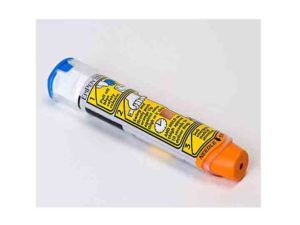Anaphylaxis Treatment
An episode of Anaphylaxis is a medical emergency. It can be fatal if left untreated.
If someone has symptoms of anaphylaxis, you should:
- Use an adrenaline/epinephrine auto-injector. Give another adrenaline injection after 5-15 minutes if the symptoms don’t improve and a second auto-injector is available
Dose of Adrenaline / Epinephrine
10-20 kg (~1-5yrs) – 0.15mg (green labelled on autoinjector)
>20kg (~>5yrs) – 0.3mg (yellow labelled on autoinjector)
Pregnant woman- 0.3mg (yellow labelled on autoinjector)
If do not have autoinjector or in hospital settings
Give INTRAMUSCULAR (IM) injection of Adrenaline/ Epinephrine as follows:
- 1:1000 solution of Adrenaline in IM into outer aspect of mid-thigh in right site.
- 0.01mg per kg up to maximum of 0.5mg per dose can be used.
- Repeat every 5 minutes as needed.
- Call emergency number for an ambulance immediately
- Remove any trigger if possible – for example, carefully remove any wasp or bee sting stuck in the skin
- Lie the person down flat. The left lateral position is recommended for patients who are pregnant.
Prevention of Anaphylaxis:
It is extremely crucial to alert all the time and follow few preventive measures to reduce the risk of anaphylaxis.
The following can help:
- Identify any triggers – Attend any allergy clinic to know what the substances you are allergic to. This will help you to plan your management strategy.
- Avoid triggers whenever possible – Once you identified the possible factors for triggering anaphylaxis then you can take avoidance measures to reduce the risk. For example if you are allergic to certain food then you have to shop very carefully.
- Carry your adrenaline auto-injector at all times with you– use it in emergency situation.
If your child has anaphylaxis, you must follow few steps to ensure your child is safe:
- Always notify key people about the child’s allergy/anaphylaxis. Inform your child care providers, school personnel, parents of your child’s friends and other adults who regularly interact with your child. Tell them that anaphylaxis is a life threatening form of allergy which require urgent intervention to save life of the child.
- Explain the anaphylaxis symptoms to persons who spend time with the child.
- Have a written action plan of Anaphylaxis. This plan should include the appropriate management strategies to care the child in emergency case of anaphylaxis. Give one copy of the plan to school authority.
- Have your child wear a medical alert bracelet or necklace to display that he/she has anaphylaxis.




